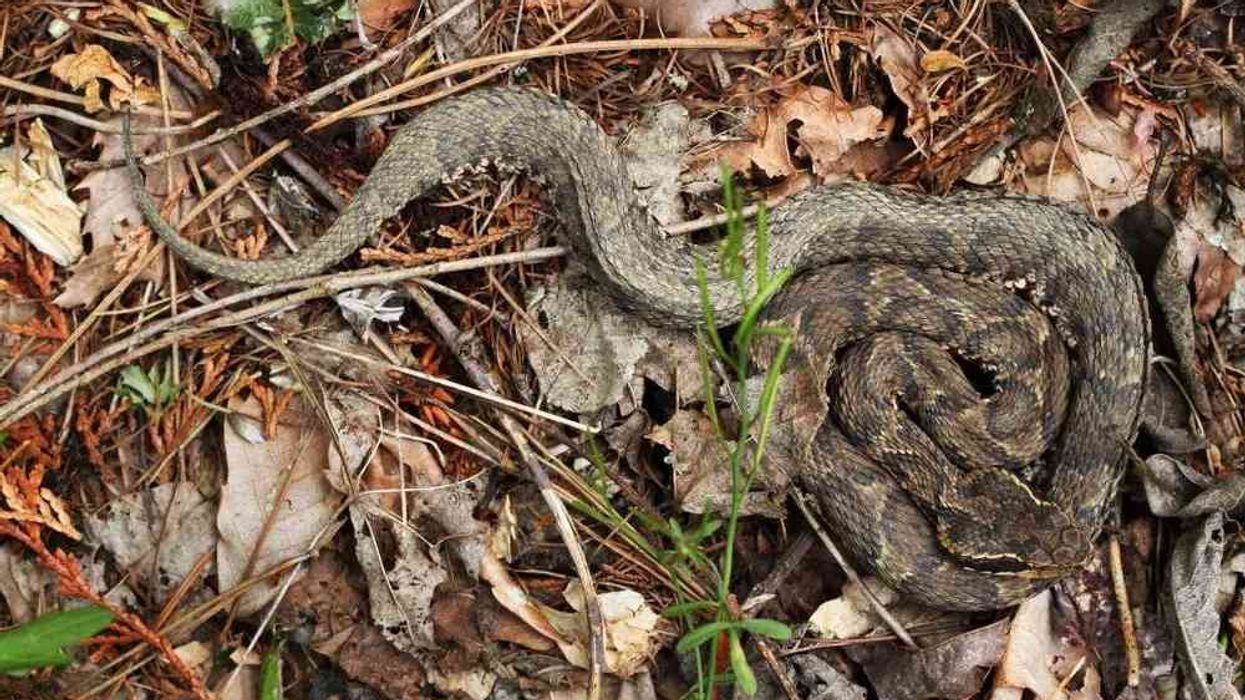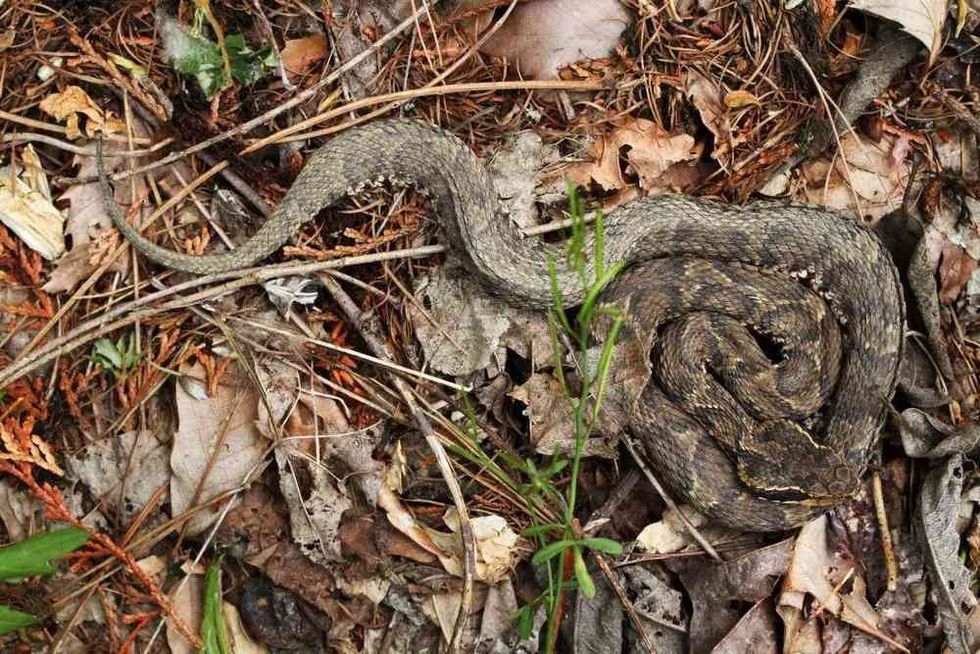Do you find amphibians and reptiles, like the species of rat snake, interesting? Then here we have all the information on the Japanese pit viper.
A Japanese pit viper snake or Japanese mamushi (Gloydius blomhoffii) is a species of pit viper. The most special thing about pit vipers is that they all are venomous snakes.
The most venomous pit viper snake is the saw scaled viper.
However, the most venomous snake found in Japan is the Japanese pit viper. These snakes are also known by many other names, like Salmusa, Japanese moccasin, Japanese mamushi, Qichun snake, and Mamushi.
If a Japanese pit viper bites you and their venom enters your system, you may need to be admitted to a hospital for several days and take an antivenom which is pretty commonly available in Japan, China, and Korea. Young or adult, all mamushi snakes are known to be most active at night.
Read on to know about the diet, geographic distribution, reproduction process, and more of the Japanese mamushi. If you like this article, then also check out anaconda snake and black racer.
Japanese Pit Viper Interesting Facts
What type of animal is a Japanese pit viper?
Japanese mamushi (Gloydius blomhoffii) is a species of snake.
What class of animal does a Japanese pit viper belong to?
The Japanese mamushi snake species belongs to the class Reptilia of animals.
How many Japanese pit vipers are there in the world?
The population of these snakes in an exact number is not known. However, their population has been reported to occur commonly within their natural habitat range. Their population trend has been observed to be stable as well.
Where does a Japanese pit viper live?
These snakes are only found in Japan. They can be found in Shikoku, Hokkaido, Kyushu, and Honshu.
They are also found in the satellite islands around the country, except for Kunasir Island and Tsushima Island. There have been reports of a number of these snakes in Sakhalin Island but no concrete proof of their presence has ever been found, even after many surveys.
What is a Japanese pit viper's habitat?
The primary Japanese pit viper habitat is the forest. They also frequent the paddy fields surrounding them. They are also found in various other habitats, like rocky hillsides, open woodlands, marshes, montane rock outcroppings, grasslands, meadows, swamps, and farmlands.
Who do Japanese pit vipers live with?
Japanese pit vipers are known to be solitary in nature. They only come together during the breeding season.
How long does a Japanese pit viper live?
These snakes have the ability to live for about 14 years on average.
How do they reproduce?
The breeding season of this snake occurs around August to October. Both Japanese pit viper male and female snakes mature sexually at about three to four years of age.
These snakes are viviparous in nature, so unlike other snakes that carry eggs, Japanese pit vipers give birth to live young neonates in a litter.
The females even have sperm storage pockets in their body which allows them to store sperm for as long as three years after they copulated. That's why some females skip breeding season for a year or two.
The gestation period in the female lasts for about two to three months.
At the end of their gestation period, the pregnant females come together at the breeding site and each of them gives birth to about 2-13 live young neonates in a litter on average. No parental care has been observed among adult snakes after the mothers give birth.
What is their conservation status?
The conservation status of the Japanese pit viper according to the International Union for Conservation of Nature is listed as Least Concern. The only minor threats their population is facing at the moment are irritation killing and exploitation for commercial uses by humans.
Their population does not have any great threats as of now within their natural habitat range, so no preservation actions are still being taken.
Japanese Pit Viper Fun Facts
What do Japanese pit vipers look like?
A Japanese pit viper snake is a medium sized snake species. They have a large oval shaped head and a short tail. Their dorsal side is keeled which makes them able to move smoothly.
They have large and round eyes. They have two venomous fangs on their upper jaw which stay connected to their venomous gland.
Their body color ranges from yellowish brown to reddish brown or gray depending on their geographical location. They have many blotches with dark-colored blotches on their entire body that gets lighter towards the center. The head of the snake is darker and it has dark stripes on the sides of its face.
How cute are they?
These snakes may not look adorable, but they sure are beautiful. However, do not be attracted to them because of their beauty as they are extremely poisonous.
How do they communicate?
Snakes, in general, communicate through chemical means. They secrete chemicals that help them ward off predators and to communicate with the opposite sex during the breeding season.
How big is a Japanese pit viper?
An adult Japanese pit viper is about 17.7-31.9 in (45-81 cm) in length. They are around nine times shorter than king cobras, who can be about 224 in (569 cm) in length.
How fast can a Japanese pit viper move?
The exact speed at which these snakes move is not known. However, pit vipers, in general, can move at a fast pace.
Sidewinder, a species of pit vipers, are the fastest snakes in the world. However, the Japanese pit viper adaptation owing to its camouflage is excellent, so they hide silently and ambush their prey rather than use speed to chase them.
How much does a Japanese pit viper weigh?
The exact weight of these snakes in an exact number is not known.
What are the male and female names of the species?
Males and females of thid species have no specific names.
What would you call a baby Japanese pit viper?
A young baby Japanese pit viper is called a snakelet or neonate.
What do they eat?
The Japanese pit viper diet is similar to carnivorous animals. Their diet primarily consists of rodents, but other than rodents, sometimes they also prey on insects, lizards, and small birds.
Are they poisonous?
Japanese pit vipers are the most venomous snake species found in Japan. Only Habu snake species found also in Japan come second to them.
Habu snake bites can cause both temporary and permanent damage to one's body. Habu snakes fatalities have been recorded to be less than 1%, but in the case of Japanese pit viper venom, the effect can be much more severe.
About 2000-3000 people get bitten by them every year and at least 10 people die every year. If they bite you, then get medical treatment and antivenom immediately, which is usually available in China, Korea, and Japan.
Would they make a good pet?
No, these snakes cannot be kept as pets, because they are extremely poisonous. Thousands of people get bitten by them each year and many of them even die. It's better to stay away from them.
Did you know...
Japanese pit vipers frequent rice paddies at night in search of rodents such as mice and rats. These snakes bite people who are unaware at night.
If the venom from a Japanese pit viper bite gets inside a person's body, it can affect their kidneys, breathing, and cause internal bleeding. Generally, a person needs to get treated in the hospital for almost 5-10 days if they get bitten.
How did the Japanese pit viper get its name and what other names does it have?
Japanese mamushi (Gloydius blomhoffii) has many other names. These are Salmusa, Japanese moccasin, Japanese mamushi, Qichun snake, and Mamushi. They got their scientific name, Blomhoffii in honor of Jan C. Blomhoffii, who was the director of a Dutch trading colony in Nagasaki.
Four subspecies of these snakes can be found. The four subspecies are Tung Ling mamushi (Gloydius blomhoffii dubitatus), Japanese mamushi (Gloydius blomhoffii blomhoffii), Yangtze mamushi (Gloydius blomhoffii siniticus), and short tailed mamushi (Gloydius blomhoffii brevicaudus).
Whats the difference between a Japanese pit viper and a tree viper?
The entire population of Japanese pit vipers is only found in Japan, whereas tree vipers are found in China, India, Malaysia, Thailand, Indonesia, and parts of Africa. While Japanese pit vipers can be found in various habitats, tree vipers are primarily arboreal.
Here at Kidadl, we have carefully created lots of interesting family friendly animal facts for everyone to discover! Learn about some other reptiles including scarlet snake facts and vine snake facts pages.
You can even occupy yourself at home by coloring in one of our free printable lined snake coloring pages.









